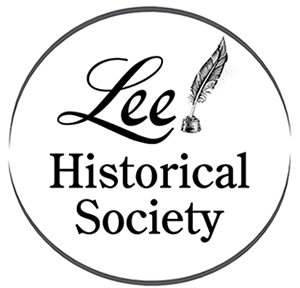



Lee Historical Society
by Phil Smith
A Brief History of Lee
In an old state like Massachusetts, Lee is a rather young town. Pilgrims came ashore here in 1620, effectively establishing the state and the Town of Plymouth, but it was well over a century before English settlers spreading across the hills took up residence in what is now the Town of Lee.
Peter Wilcox built a log house in the present downtown about 1760, becoming the first English settler, but the Mohican tribe had been here centuries before, using the land largely as a hunting ground. The land was purchased from the Native Americans and Lee was carved out of other towns. Small settlements sprang up in the mid 18th Century at Dodgetown in East Lee, Hoplands to the south and Glassworks Grant, now Main Street. Most early settlers were farmers living off the land. An ecclesiastical society was formed, a meetinghouse was built, and the town was incorporated in 1777. The Revolutionary War was in its early stages and the town was named for Maj. Gen. Charles Lee, who would become a controversial figure.
The town found a source of wealth in 1806 when Samuel Church came and established a small paper mill in South Lee. Fast running streams for power and pure water for processing made it a good place to produce paper and the industry caught on. But Lee was still a remote and hard to reach place. Most trade was via teamsters and boats in the Hudson River.
Just before mid-century, the Housatonic Railroad pushed through, improving the connection to the outside world. By 1857, Lee had 25 paper mills concentrated in East Lee and along the length of the Housatonic River. Smith Paper became the biggest of the producers and it was the first company in the United States to mass-produce paper made from tree fibers. A second major industry had popped up in the form of marble quarrying, made possible by the rail line. High quality Lee marble would find its way into famous buildings including the U. S. Capitol wings, St. Patrick’s Cathedral and the Boston Public Library. Lee was soon established as a hard working blue-collar hilltown community struggling bravely for survival and helping to build a great nation.
Originally a Congregational church town (the established state religion) of people whose roots were mostly in the British Isles, the railroad and industry brought new populations of Irish and Italian workers. With them came a Catholic church. These were tough and determined people eager to make a better life for their families. The town prospered from their labors. As the United States was faced with a series of wars the town sent its able bodied citizens to defend the nation. Our cemeteries today are full with the remains of veterans who answered the call. Lee even produced a winner of the Congressional Medal of Honor, James M. Burt, a World War II tank commander.
East-West travel had improved with the building of the Western Railroad through Pittsfield in the 1840’s. Highway travel east to the Boston area also saw a major improvement with the completion of the Jacob’s Ladder Highway in 1910. It was the first modern surfaced highway in America that crossed a mountaintop and in 1926 it was designated US Route 20. Today that same road is extended from Boston to Newport Beach, Oregon, the nation’s longest numbered highway. With the coming of the automobile, Lee first began to realize its potential as a tourist town in the 1920’s and the Lee Chamber of Commerce was formed.
Lee was never the darling of the ultra rich families that built those spectacular Berkshire cottages. Among the 90 or so estates established by the Gilded Age tycoons, only Highlawn House of the Vanderbilt family is physically in Lee. Parts of George Westinghouse’s Erskine Park estate sprawled over the Lenox line into Lee as well. Nonetheless, Lee entertained its share of summer visitors, often at the famed Greenock Inn.
Lee’s bustling downtown continued to grow, but fires and floods often took their toll. Booming through the Roaring Twenties, Lee business took a major hit during the Great Depression of the 1930’s. Much trade appears to have been lost to Pittsfield and Great Barrington, but Lee kept its core of downtown stores.
Faced with foreign competition and increasing costs, the paper and marble industries were in slow decline in the mid-20th century. The town’s economy was again shifting. The opening of the Massachusetts Turnpike in 1957 gave Lee the principal Berkshire exit and routed traffic through the town. Lee became known as “The Gateway to the Berkshires,” and its reliance on the visitor economy grew. A large outlet mall was built near the turnpike exit, opening in 1997, attracting two million shoppers per year.
Today’s economy is increasingly diverse as is the population. Restaurants and inns serving visitors have proliferated. Second homes have become common, but many “snowbirds” fly south for the winter. Lee is a full service town, with a large supermarket, drug stores, gift shops, antique stores, barber and beauty shops, able to fill most needs. One large dairy farm is in operation as well as smaller farms producing meat products, wool and in-season produce. One paper company, locally owned and smartly managed, carries on a two-century tradition. The quarries are still there, producing mostly limestone products. Three firms are competing in the burgeoning biomedical field, another is growing in the protective systems industry and yet another fulfills online orders. Lee has always been good at making useful products and that has never changed.
Lee’s future looks bright. It’s the kind of town Norman Rockwell loved to paint and a place of small town living which many Americans long for. Even in the face of declining population in Berkshire County, Lee has prospered.
If you want to know more about Lee history we recommend these sources:
• See All the People: (Or Life in Lee (Massachusetts)),
See All the People: (Or Life in Lee (Massachusetts)),
by Florence Consolati. (1978)
• Lee. A Centennial and A Century,
Lee. A Centennial and A Century,
by Rev. C. M. Hyde and Alexander Hyde. (1878)
• History of Lee, Mass: A lecture delivered before the Young Men’s Association, March 22, 1854, by Rev. Amory Gale, (1854)
History of Lee, Mass: A lecture delivered before the Young Men’s Association, March 22, 1854, by Rev. Amory Gale, (1854)
